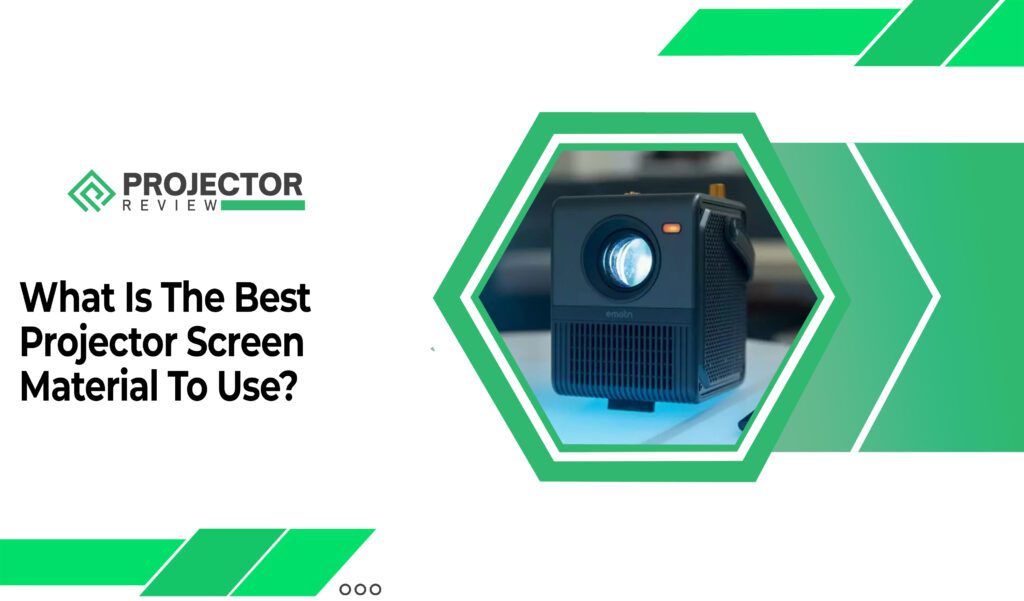Have you ever been directed to your projector on the wall, just for the picture to be terrible? Has your wall ever absorbed all of the colors and contrasts of your projection, making it dull and lifeless? It happens too often.
The problem with the use of walls for projectors is that they did not do this task. Ordinary colors are not suitable and good for projectors; your images will not be clear and bright. That’s the reason you have to need Paint for Projector Screen.
Paint on Screen offers cost-effective solutions for the entire large media industry. These savings are easy to see in schools, churches, convention centers, conference rooms, hotels, sports bars and restaurants, stadiums, large venues, theater productions, and many other industries.
But what type of paint you should use for the projector screen? What is the best color for a projector screen? How does the projector work on the black wall? And what are the best paints for the projector wall? All these questions are answered in this article.
Can I Paint A Projector Screen?
Yes, you can paint a projector screen with projector screen paints. Paint for Projector Screens can be applied to almost all surfaces. They are suitable for use on plaster, wood, metal, and concrete. Projector paint makes a surface more reflective.
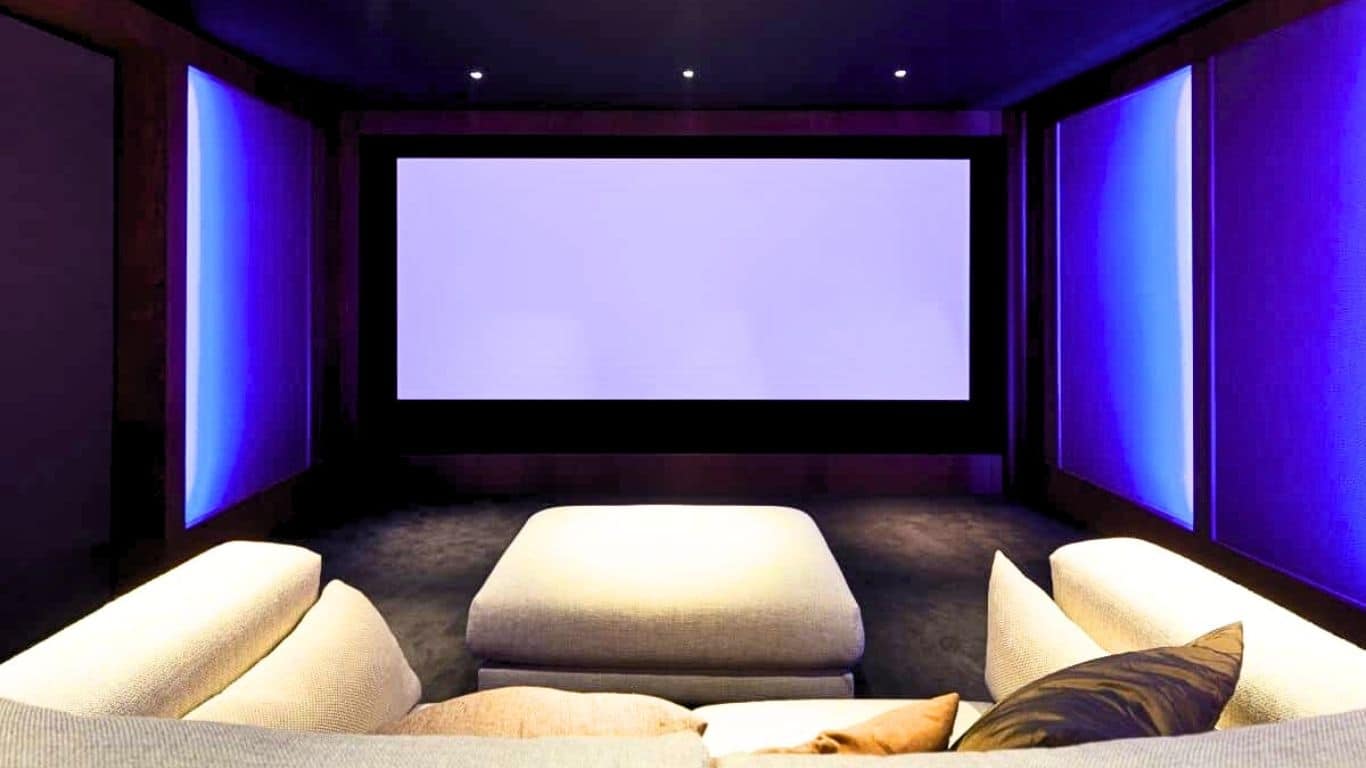

However, a rough surface on the wall does not suddenly become smooth enough for the projector to receive an image without the images becoming blurred or distorted.
What Type Of Paint To Use For the Projector Screen?
There are two main paint types of Paint for Projector Screens:
Acrylic paints
These paints are high and low temperature resistant, and also moisture, and are good for both indoor and outdoor use in several weather conditions.
High-quality projector paints are mainly acrylic paints because they don’t consist of as much vinyl as latex and other paints. Vinyl is used for increasing the coat area of the paint can, but it decreases its lifespan.
Latex paints
Actually, they are a sub-category as these colors are also acrylic paints. They consist of more vinyl but in comparison to pure acrylic paints, they are much cheaper. These colors lose their durability when used outdoors because they do not have the same temperature nor the same water resistance.
Factors On Which Type Of Paint Depends
The type of paint you need for the best performance depends on a few factors. Each of the three factors affects the brightness of the projection screen.
- Projector Lumen Output
First of all, it should be clear that a white screen reflects more light than a black or gray screen. If your projector cannot produce sufficiently bright light, a gray projection screen is out of the question.
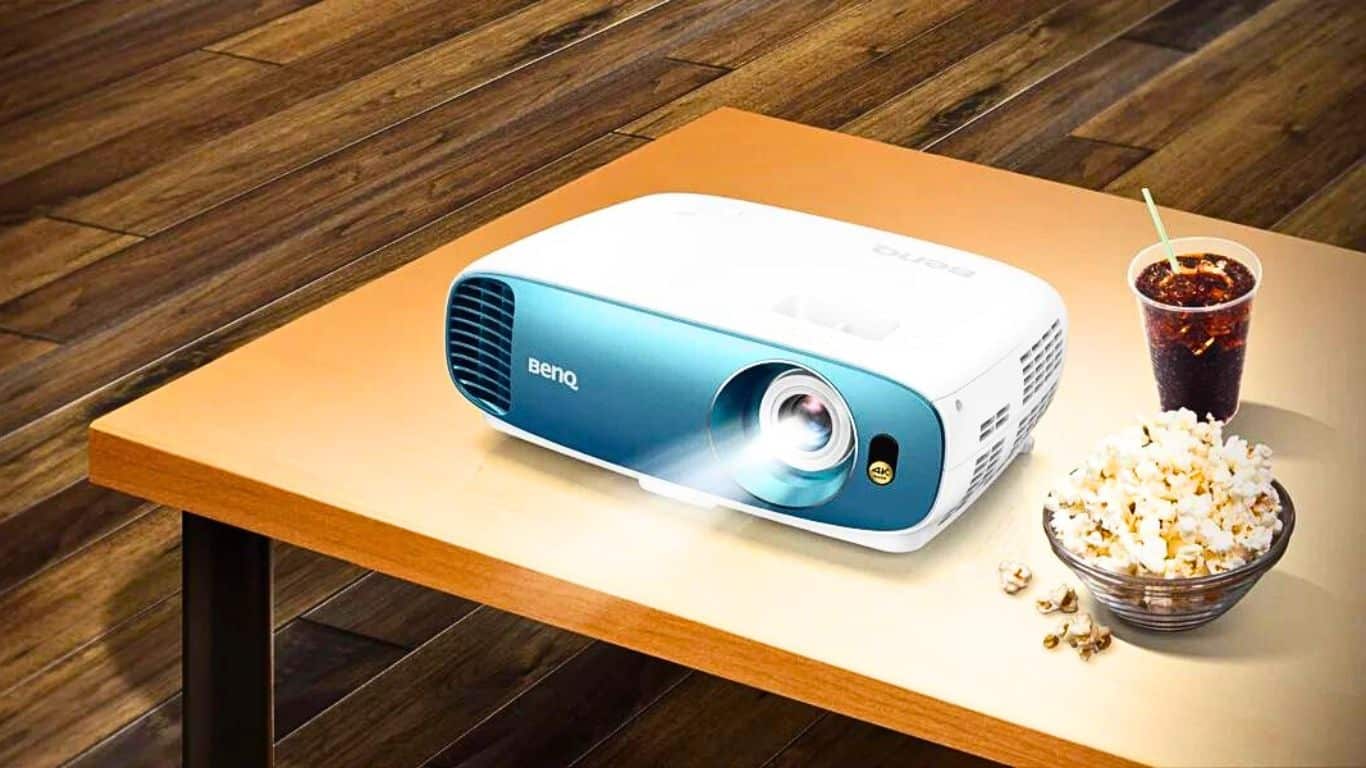

For projectors like this, you need a white projection screen with significant gain so that it can reflect enough light back so that the image does not appear dull or discolored.
On the other hand, if you have a bright projector that can produce 3000+ lumens of light, you have the option of choosing a white or gray screen depending upon ambient light and personal preference.
- Ambient Light In The Room
Projectors with smaller lumens and rooms with more ambient light need a more reflective color to get a sharp color.
On the other hand projectors with higher lumens and lower ambient light require less reflective paint that does not cause glare.
See if there is a lot of ambient light coming from windows and other openings. Ambient light is any light that does not come from the projector. Even the best projector can fail if the room is too bright. It is reflected on the screen making the image appear blurred and devoid of contrast.
- What Will You Be Watching?
The same goes for what you see. The lighter programs require less reflective paint and the darker programs require more reflective paint. I’ve found that video games and HD movies need a bit more reflectivity to produce the contrast needed for the deep black color of these media.
What Is The Best Color For A Projector Screen?
What is the best paint color for a projector screen? Don’t worry we will tell you below about the paint color which is good for a projected screen.
1. White Paint
Among all white color is the most neutral. However, normal white color cannot be used. You need to turn those that are used for projection screens or even walls into projection screens. Their color should give a smooth surface that will reflect the slightest amount of Light for every eventuality.
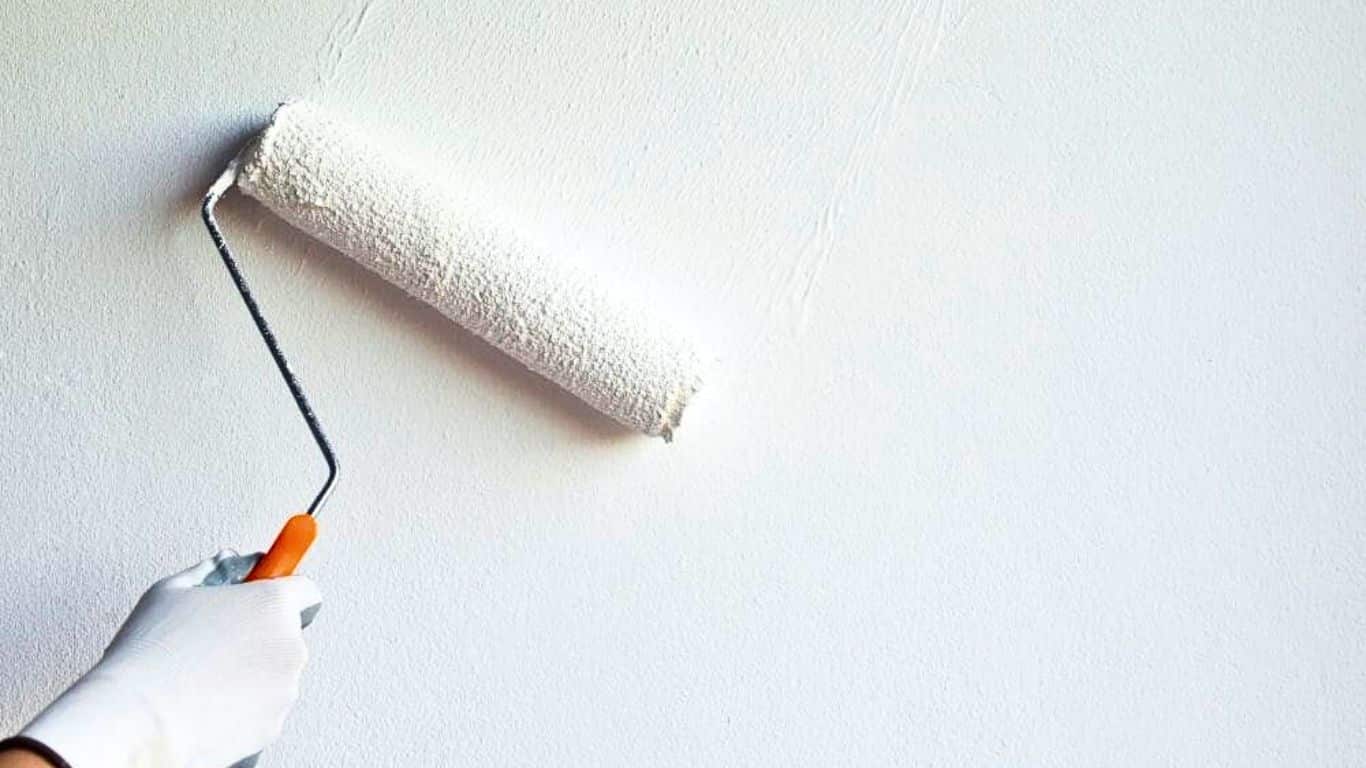

- White Screens and Neutral Gain
White color is a popular screen color because its color is clear with neutral reinforcement. Gain means reflective properties amount that paint creates or the light proportion that is reflected off a surface by a source of light. The meaning of Neutral gain is that there is no gain from white paint.
- White Paint Benefits
Painting a wall or screen white will ensure that the video will faithfully reproduce on the screen. Because of their color accuracy and brilliant white tones, they remain the current screen color standard when projecting videos onto the screen.
They are great for PVC material as it provides an illumination effect that comes to shove when pushed. In addition, this color option offers viewing angles that are much more generous compared to other colors. Black levels work weaker with white
2. Gray Paint
This color was first introduced by Stewart Filmscreen’s Grayhawk product. It is commercially well solid. Compared to white “vanilla” projectors, they had better black levels and good absorption of ambient light. However, digital light processing (DLP) projectors made them almost obsolete.
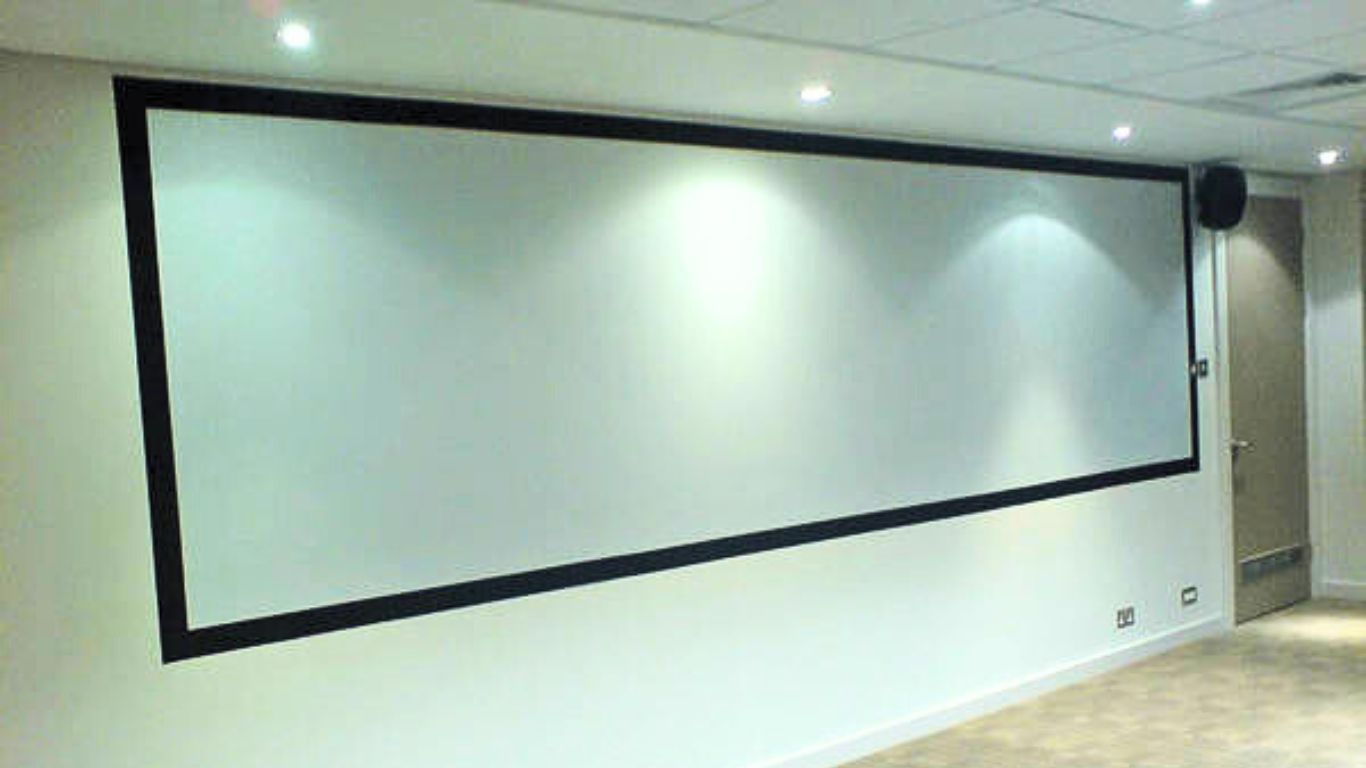

- DLPs vs. Gray Paint Screens
Before the HDMI connections invention, everyone was talking about gray screens as an alternative to white screens; However, as technology evolved and DLPs produced deeper black images also on white screens, very few people were buying screens painted gray.
It doesn’t hurt to have a gray screen that leads to their black levels blacker and it is not necessary to paint the screen black and overdo it. DLP in combination with gray screens creates a rich, high-contrast display.
3. Silver Paint
Have you heard “Silver Screen” when you are talking about films made during Hollywood’s Golden Age? Silent films and “movies” (moving projected video or images VS image slideshows which are still) used silver color on screens for increasing gain.
- Why Silver Paint was important Back in the Day?
In the past, silver was necessary because projectors from back then couldn’t keep up with the brightness or contrast ratio of today’s projectors. They had incandescent lamps or even gas lamps.
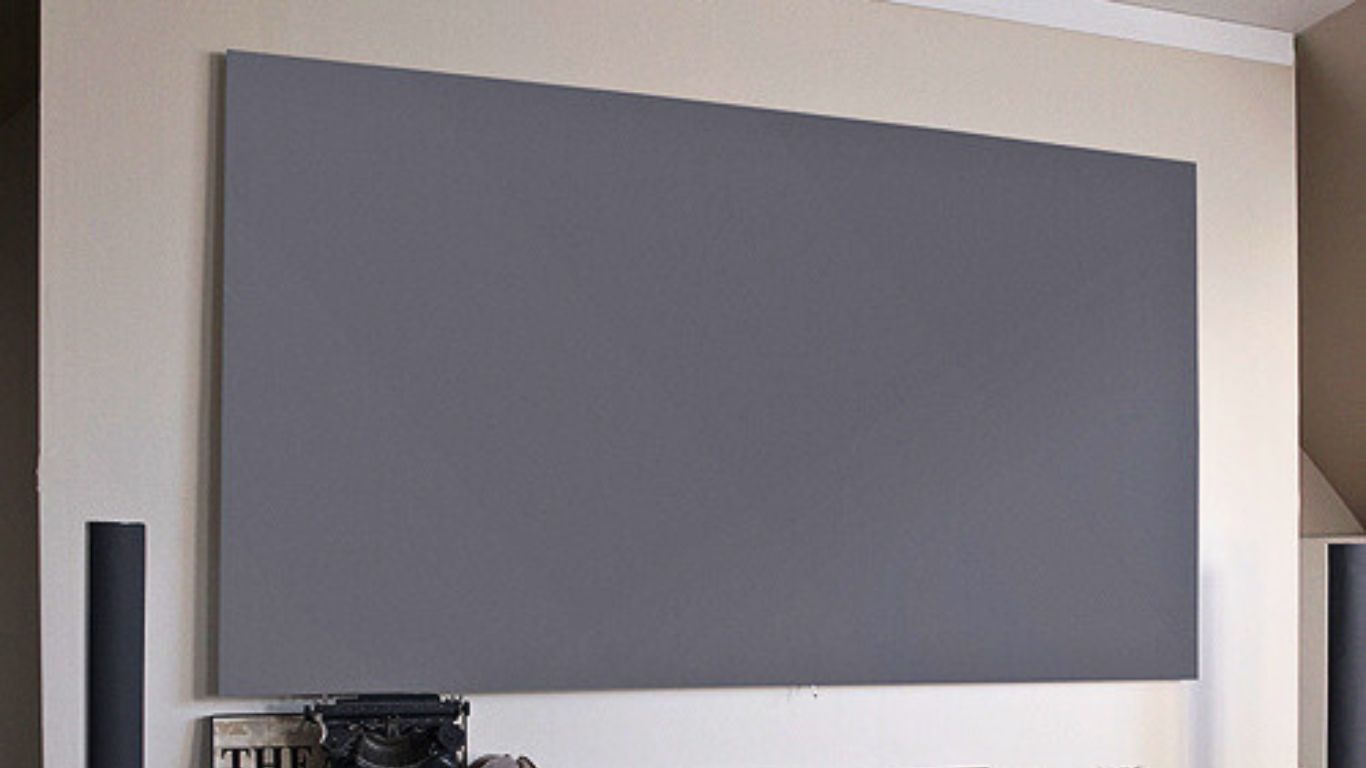

This needs a super glossy and super reflective surface of the paint. Today’s lacquers are easily present in matte colors, as an image that is too glossy will result in an image that will be very bright for the eyes. This was not the case in the Hollywood and Silent Movie era.
- Hot Spotting Issues and Silver Screen Advancements
Hot spots occur whenever a bright spot shows on your screen making viewing difficult. White and gray both screens neutralize hotspots. The reflective materials on the silver screens don’t, so it’s still a problem.
It is solved by finding a surface that better diffuses the properties of silver. Current silver displays like the 122 = inch Vutec SilverStar prevent smudging with proper light scattering. The silver color you choose should also have scattering properties.
4. Black Paint
Last but not least is the black color. There’s a reason black color is not a common screen color among the common white, gray, and silver colors. That’s because it’s ten times gray. The contrast it offers is too great and the color becomes too light. The ambient light absorbs too well.
- Black Screen Benefits and Recommendations
When purchasing a black screen paint bucket you have to take care that you have one with deep color saturation. Backgroundless black levels are the default setting for every black screen color. It uses screen or wall material that encourages better light diffusion.
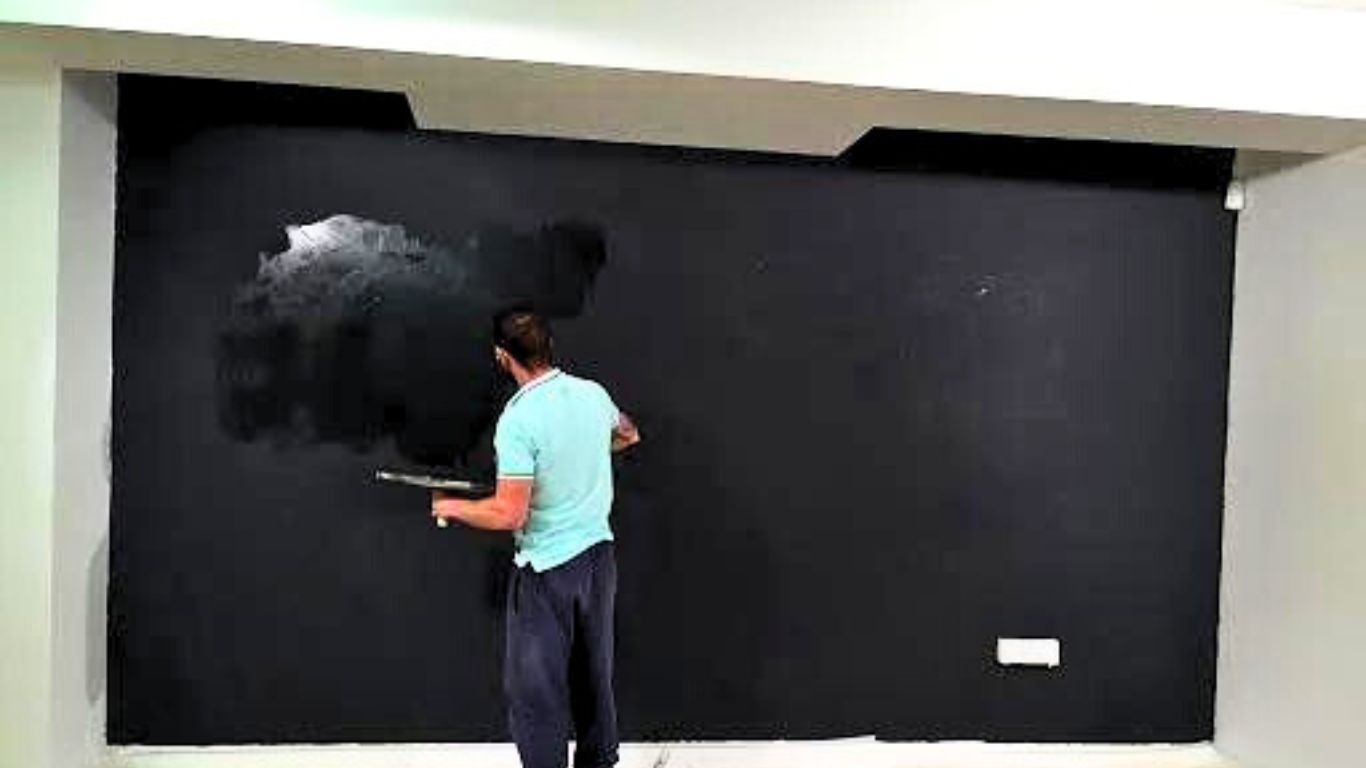

That way, you can better enjoy the black screen benefits such as an improved reproduction of the darkest parts of the picture or a better representation of light colors on the darker screen through contrast. The contrast values can go through the roof without the aid of the projector.
Does the Projector Work On a Black Wall?
Using A Projector On Black Walls
The black finish simply takes the concepts that apply to gray surfaces a step further. By making the projection surface black, the black level is improved even more than on a gray surface.
The black screen absorbs more ambient light, so darker blacks will look better than a gray screen when you start increasing the ambient light.
As the darkness increases, it increases the contrast between black areas and other colors. A black screen can prevent some, but not all, of the dull colors, that a gray screen produces. Generally, when there is more ambient light the projection surface you may need.
What To Consider When Using A Projector Black Walls?
If you already have a wall painted gray or black that you want to use, give it a try. When it delivers the desired image quality in the desired lighting conditions, you’re good to go. Otherwise, in addition to the ambient light, you should consider the following when projecting onto gray or black walls:
- The amount of light your projector emits, plus the distance from and size of your screen area
- The amount of light your wall reflects.
As you can see, it’s possible to use grey or black walls as a projection surface. But you’ll need to consider:
- The ambient lighting in your viewing room
- Your projector’s lumen level
- The screen size and distance from your projector
- Your wall’s gain
Do Black Screens Decrease the Quality of the Viewable Image?
There is a projection screen or projector to confirm that the image projected, from a computer UI having a projector, is perfectly visible as a video or presentation of image images.
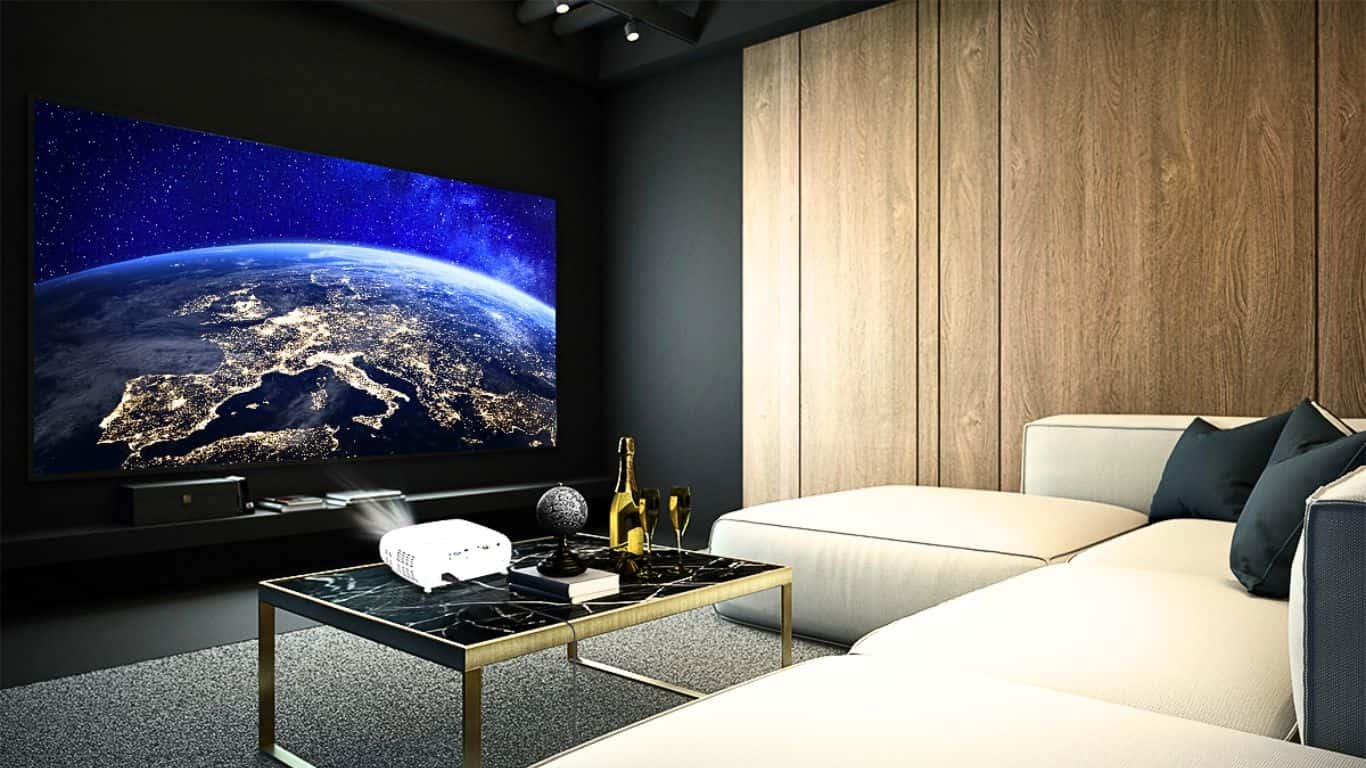

If you are consuming different surfaces to project images, such as For example, walls, ceilings, floors, curtains, or a hanging sheet, then you will face awkward type neck angles or surfaces that move or are not suitable and that much smoother for your needs of viewing which leads to a deterioration in the quality of the visible image.
Best Wall Paint For Projector Screen
We selected the two best wall paint for the projector screen which are Paint On Screen Projector Screen Paint G005 and Ultra HD Premium Screen Paint. Their features, Pros, and Cons are given below:
1. Paint On Screen Projector Screen Paint G005
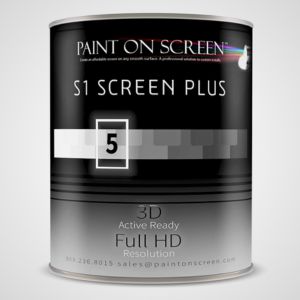

The best choice for your projector is special screen paints. They are pretty easy to find and are designed to offer the best home theater experience.
To turn any wall, ceiling, floor, dome, window, building, or other surface into a beautiful and very effective HD projection screen Pint on Screen makes this very easy for us. Sometimes many people paint the whole wall or just the size of the screen with a border or frame.
No other product is performed in any way with a higher standard than the paint on the screen. It was designed as a simple spray or spray solution that would handle any video projection variable.
Key Features
- Grey silverish color
- It is not washable
- supports Full HD and 4K resolution
- Its gain value is 2.0
- 3D compatibility
- 1gal volume
Other Features
- This projection screen paint is available in silver which makes it very versatile so you can use it in almost any situation; it has a great combination of brightness and contrast.
- It also has a good balance between gloss and matte. It doesn’t shade your wall or swallow the colors.
- The S1 screen Plus projector is also compatible with HD. So if you have HD footage, don’t compromise when it comes to projecting it on the You will receive the Full HD footage with this painting.
2. Ultra HD Premium Screen Paint
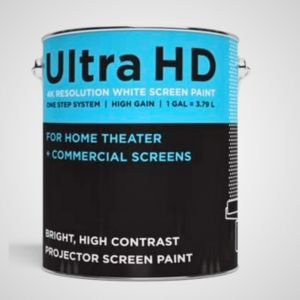

A very impressive 4K HD projector painting that allows you to enjoy the best possible image quality without cropping. Plus, you won’t find any glare or odor issues with the paint.
Digital Image Screen Painting offers you an HD solution for the best possible image. With Projector Screen Paint from Digital Image, you get a high-contrast resolution and plenty of space for your screen.
This company has an excellent reputation for making beautiful products so you know you are getting a high-quality option. Known for its reliable products, Digital Image Display Paint gives you what you need.
Key Features
- Low odor
- One gallon costs $159.95 plus s & H ($10.99) and covers two coats on a 16 x 10 wall screen
- Recommended for churches, conference rooms, hotels, and classrooms
- 50% brighter than a standard white wall
- Cured and ready to view in 24 hours
- No volatile organic compounds (VOCs)
- High contrast/high resolution 1080p
- Roll on or use a sprayer
Other Features
- You can create a screen up to 240” diagonally so that anyone can watch a movie from anywhere in the room.
- You can cover a 16 by 10-foot surface with just one gallon of this paint.
- The paint offers a very neutral color change and can be applied to any flat, smooth surface such as a wall, ceiling, exterior wall of a building,
- This paint is VOC-free, which means that it is safer and has less odor compared to ordinary screen paint.
- It comes 19 inches diagonally so you can get a lot out of this
How To Paint A Wall For Projector?
How can you paint a wall for a projector? Don’t worry, the process is so simple, Anyone can paint their own projector wall, and you no longer need the professionals to do it for you, all you need are 6 simple steps.
Select The Wall
You can’t just use any old wall in your home. You need to find a wall big enough to handle the size of your screen while leaving some room around the edges. Different input sources have different image display sizes, so make sure the wall can handle a wide variety of displayed images.
Prepare Wall
After you’ve selected your wall, you’ll need to clean the wall and check for blemishes such as bumps and textures from previous paint jobs. The best approach to this task is to make the room as dark as possible and find raised areas with light directed along the wall surface.
No matter how good the paint you use, if the wall isn’t primed it won’t work well. That is why you need to smooth the wall first. A great way to do this is by grinding. Use light sandpaper to level the raised areas of the wall. This step is a bit of a chore, but it helps avoid image distortion.
A great way to ensure this is by using a flashlight. Stand aside and flash through the wall. Your flashlight makes all bumps on the wall visible. Once the wall is level, use soapy water or mild detergent to remove dust and dirt from the wall so your new paint will adhere evenly and properly.
Measure Projection
If you want to paint the entire wall, you can skip this step. However, if you want the best results, it is best to only paint the area with the projection.
So before you start painting, first test your projector, turn it on, and outline its edges with masking tape. That way, you’re only painting the areas that need painting.
Paint!
Now it is time to paint! Always follow your projection screen paint manufacturer’s instructions for the best results for your wall.
Most of them instruct you to apply a double coat – apply one coat, wait for it to dry, and then apply the next. This ensures that you get a solid color but also retain some light transmission.


Be sure to apply the paint evenly. You don’t want some areas to be darker than others. A little care in painting will improve the final product dramatically.
Add Borders
When the paint dries, you’re done! If you want to make things better you need to add some boundaries. Adding a black border around the projector wall increases the contrast. It will draw your eyes to the projector screen. This little addition adds significantly to the quality of your experience.
Black borders work best, but you can choose any color. Some people even build wooden frames for their home theater for this. The easiest to use, however, is the black edging tape.
The Finished Product
With these simple steps, you can take your viewing experience to a whole new level. Your pictures will be much better and clearer. You’ll never want to come back after you’ve tried projection color visualization.
Never forget to consider your projector’s capabilities and take the time to choose your color. Don’t rush to work and you’ll never have to pay for overpriced popcorn and candy again.
Projector Paint vs. Projection Screen
Projector Paint
Projector paint refers to a specialized type of paint that is designed to be applied directly to a wall or projection surface to create a projection screen. It is formulated with reflective properties to enhance the brightness and contrast of projected images. Here are some key points to consider:
- Ease of installation: Projector paint offers a simple and cost-effective solution since it can be applied directly to a wall, eliminating the need for a separate screen installation.
- Flexibility: With projector paint, you have the flexibility to choose the size and shape of the projection area, as it can be applied to any suitable surface, including curved or irregular walls.
- Ambient light control: Some projector paints are designed to enhance image visibility in rooms with ambient light by minimizing glare and increasing image contrast.
- Surface quality: The quality of the surface on which the paint is applied can affect the image quality. Smooth, even surfaces tend to produce better results.
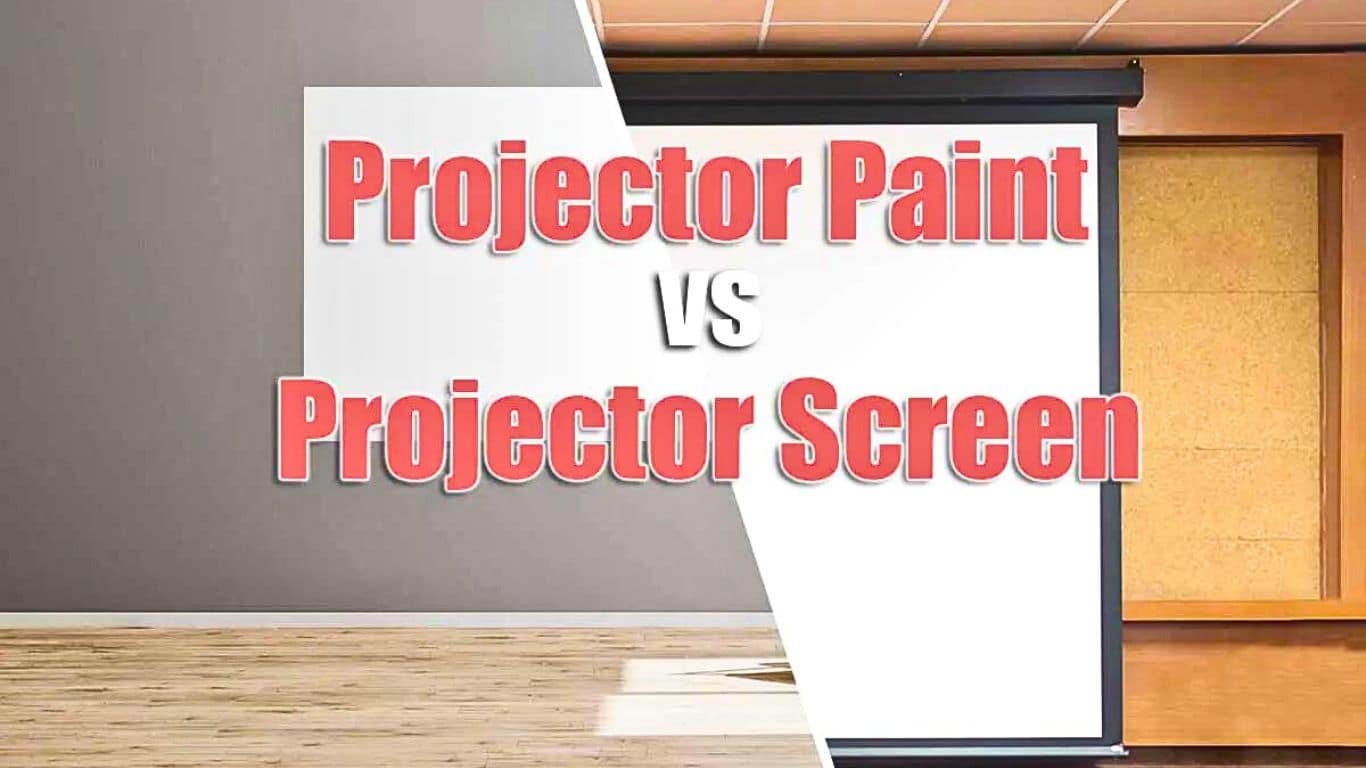

Projection Screen
A projection screen is a dedicated surface designed specifically for projecting images. It is typically made of reflective material with properties optimized for optimal image quality. Here are some key points to consider:
- Image quality: Projection screens are specifically engineered to optimize image quality, brightness, contrast, and color accuracy, providing a superior viewing experience compared to regular walls or surfaces.
- Size options: Projection screens come in a variety of sizes, allowing you to choose the screen that best fits your space and viewing requirements.
- Portability: Many projection screens are designed to be portable and easily set up and taken down, making them convenient for use in different locations.
- Ambient light rejection: Certain projection screens are designed to reject ambient light, minimizing the impact of external lighting conditions and improving image visibility in well-lit environments.
Paint For Projector Screen – FAQs
Conclusion
Paint on a projection screen is a wonderful substitute for a fabric screen. It has many advantages such as lower cost, easy application, hassle-free use, no professional help required, easy reapplication when needed, and more.
A painting on your projection screen is a wonderful substitute for a canvas screen. It has many advantages, such as lower cost, easy application, hassle-free use, no professional help required, easy reapplication when needed, and more.
